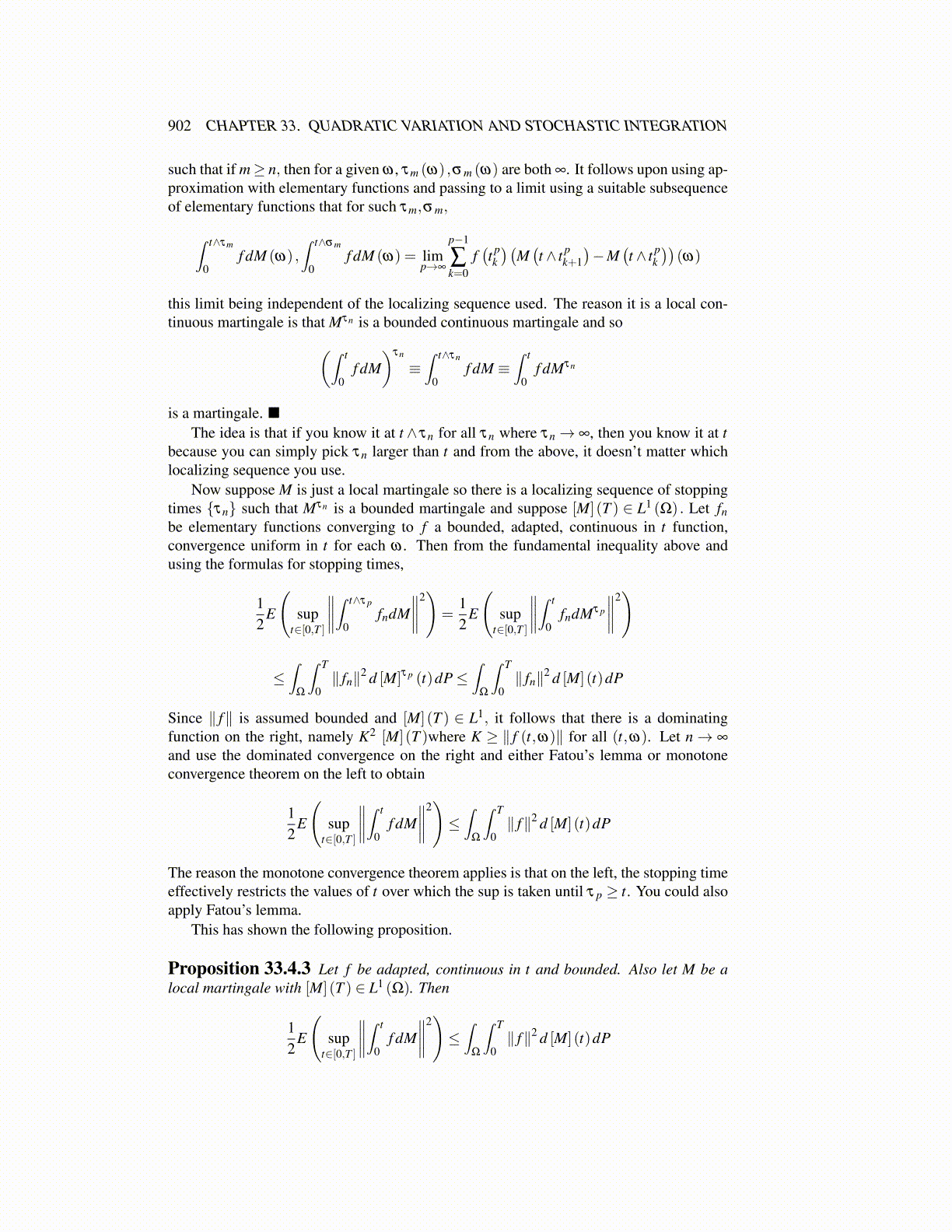
902 CHAPTER 33. QUADRATIC VARIATION AND STOCHASTIC INTEGRATION
such that if m≥ n, then for a given ω , τm (ω) ,σm (ω) are both ∞. It follows upon using ap-proximation with elementary functions and passing to a limit using a suitable subsequenceof elementary functions that for such τm,σm,
∫ t∧τm
0f dM (ω) ,
∫ t∧σm
0f dM (ω) = lim
p→∞
p−1
∑k=0
f(t pk
)(M(t ∧ t p
k+1
)−M
(t ∧ t p
k
))(ω)
this limit being independent of the localizing sequence used. The reason it is a local con-tinuous martingale is that Mτn is a bounded continuous martingale and so(∫ t
0f dM
)τn
≡∫ t∧τn
0f dM ≡
∫ t
0f dMτn
is a martingale. ■The idea is that if you know it at t ∧ τn for all τn where τn→ ∞, then you know it at t
because you can simply pick τn larger than t and from the above, it doesn’t matter whichlocalizing sequence you use.
Now suppose M is just a local martingale so there is a localizing sequence of stoppingtimes {τn} such that Mτn is a bounded martingale and suppose [M] (T ) ∈ L1 (Ω) . Let fnbe elementary functions converging to f a bounded, adapted, continuous in t function,convergence uniform in t for each ω . Then from the fundamental inequality above andusing the formulas for stopping times,
12
E
(sup
t∈[0,T ]
∥∥∥∥∫ t∧τ p
0fndM
∥∥∥∥2)
=12
E
(sup
t∈[0,T ]
∥∥∥∥∫ t
0fndMτ p
∥∥∥∥2)
≤∫
Ω
∫ T
0∥ fn∥2 d [M]τ p (t)dP≤
∫Ω
∫ T
0∥ fn∥2 d [M] (t)dP
Since ∥ f∥ is assumed bounded and [M] (T ) ∈ L1, it follows that there is a dominatingfunction on the right, namely K2 [M] (T )where K ≥ ∥ f (t,ω)∥ for all (t,ω). Let n→ ∞
and use the dominated convergence on the right and either Fatou’s lemma or monotoneconvergence theorem on the left to obtain
12
E
(sup
t∈[0,T ]
∥∥∥∥∫ t
0f dM
∥∥∥∥2)≤∫
Ω
∫ T
0∥ f∥2 d [M] (t)dP
The reason the monotone convergence theorem applies is that on the left, the stopping timeeffectively restricts the values of t over which the sup is taken until τ p ≥ t. You could alsoapply Fatou’s lemma.
This has shown the following proposition.
Proposition 33.4.3 Let f be adapted, continuous in t and bounded. Also let M be alocal martingale with [M] (T ) ∈ L1 (Ω). Then
12
E
(sup
t∈[0,T ]
∥∥∥∥∫ t
0f dM
∥∥∥∥2)≤∫
Ω
∫ T
0∥ f∥2 d [M] (t)dP